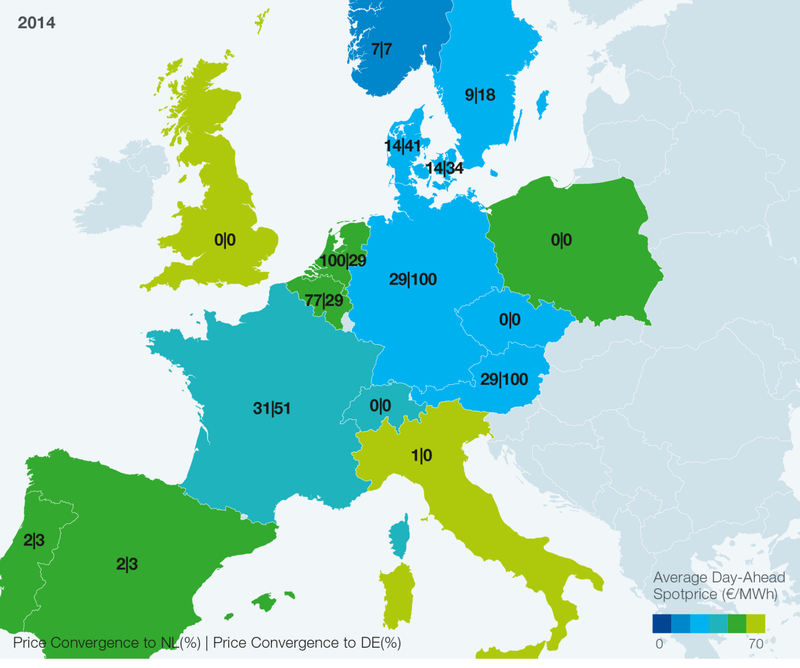News Release from windfair.net
Wind Industry Profile of
Electricity prices in the Netherlands decrease by over 20 percent in 2014
In 2014 the average price for a megawatt of electricity in the Netherlands amounted to 41 euros, down more than 20 percent from 52 euros in 2013.
These developments mean that market prices in the Netherlands and Germany are gradually converging. Whereas prices were equal in both countries for 19 percent of the time in 2013, this figure rose to nearly 30 percent in 2014 (see Figure 1). These are some of the highlights of the latest Market Review prepared by electricity transmission operator TenneT. In this publication TenneT reviews and analyzes relevant market developments, including price developments in the European wholesale electricity market in 2014. The market analysis focuses on the Netherlands and its neighbouring countries: Germany, Belgium and France.

Figure 1: Price convergence to the Netherlands and Germany in various European countries in 2014. The first figure given for each country refers to price convergence in relation to the Netherlands, while the second figure refers to price convergence in relation to Germany. For instance, the figure 100/29 for the Netherlands means that prices in the Netherlands and Germany were the same for 29% of the time in 2014.
The price decrease in the Dutch market in 2014 is attributable to various causes. Average gas prices were lower than in the previous year, three new coal-fired power plants were taken into operation, a number of gas-fired plants were taken out of operation, and cheaper electricity was imported from Norway and Germany on a large scale. This was possible thanks to the land-based and subsea electricity connections (known as ‘interconnectors’) that link the Netherlands to its neighbouring countries. The Netherlands is one of the world’s most interconnected countries in this respect, serving as a major electricity hub.
Coal-fired power plants and interconnectors provide flexibility
Renewable energy sources like wind and solar provide a fluctuating electricity supply. Their strong growth requires greater flexibility from the electricity production system, which must be able to import electricity when the supply of solar or wind energy decreases. This flexibility is provided by cross-border electricity connections which enable the import or export of electricity. For instance, Figure 2 shows an immediate rise in exports from Germany during periods of high solar energy generation.

Figure 2: Annual average net exports (exports minus imports) of commercial electricity flows, and hourly feed-in of solar energy in Germany.
The Netherlands benefits from this arrangement because it is able to import cheaper (subsidized) electricity via the aforementioned interconnectors. However, Germany also benefits because solar energy can be exported to generate more income. Furthermore, this results in a reduction in the lower renewable energy surcharge payable by German consumers. In this way interconnectors contribute to the optimum deployment of renewable energy sources in Europe.
Besides interconnectors, conventional power plants also have a contribution to make in ensuring a flexible electricity supply. In Germany, this role is increasingly fulfilled by coal-fired plants. A similar picture may emerge in the Netherlands, due to the expected major increase in renewable electricity production in the coming years (by onshore and offshore wind farms and solar panels). The market position of modern coal-fired power plants is expected to improve in the Netherlands as well, with three new, flexible coal-fired plants recently taken into operation and a number of gas-fired plants taken out of operation. In addition to their existing base-load function, these coal-fired plants can also fulfil a flexible role in the electricity supply system.
Market conditions for gas-fired power plants are currently unfavourable in the Netherlands and particularly in Germany. Electricity prices in Germany are determined by coal-fired power plants. At the current gas prices, German gas-fired plants cannot be profitably deployed. Prices in the Netherlands are usually determined by gas-fired plants, but these plants are also finding it difficult or impossible to achieve sufficient return on investment. Gas prices are simply too high compared to the income generated from the sale of electricity.
Efficient use of interconnectors
Markets and consumers are now truly reaping the benefits of the integration of the European electricity markets, a process initiated by TenneT several years ago. The subsea NorNed cable linking the Netherlands and Norway is used almost 100 percent of the time to import cheaper electricity from Norway. The three interconnectors between the Netherlands and Germany are largely used for electricity imports, while the subsea BritNed cable between the Netherlands and the United Kingdom exports electricity to the UK for most of the time.
Dutch electricity consumers benefit to the tune of 80 million euros per year
TenneT and many other European TSOs are taking additional steps to increase the efficiency of the European electricity market. The introduction of a market mechanism called Flow-Based Market Coupling is resulting in further optimization of the deployment of the transmission capacity of cross-border electricity connections, yielding expected benefits for Dutch electricity consumers. Last week, the Dutch Authority for Consumers & Markets (ACM) approved implementation of this mechanism. Last year the ACM calculated the benefits for consumers to the tune of 80 million euros per year. Flow-Based Market Coupling is expected to result in further reduction of price differences between the Netherlands and Germany, and will be introduced throughout Europe in May of this year. The Market Review includes a number of examples that explain the benefits of Flow-Based Market Coupling.
- Source:
- TenneT
- Link:
- www.tennet.eu/...

